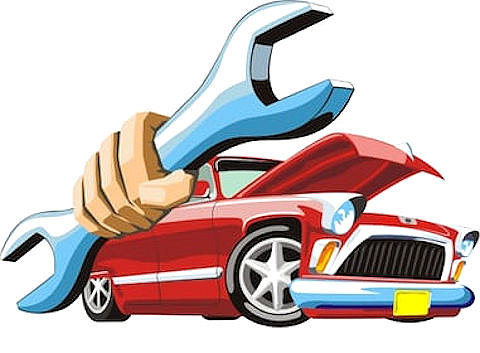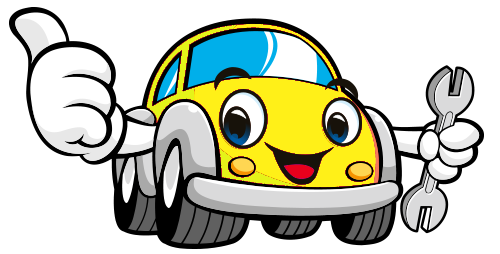

Mobile users:
For best results, view in Landscape mode.
.

Preventive maintenance can
save you money on repairs.
Winter Season Tip:
On cold winter mornings, do not rev up the engine after you
start it.
Allow your engine to run at idle speed for a few minutes before
starting out, especially when it's below 10 degrees.
Then drive moderately until it warms up.
Warming up the engine for more heat inside the car may be nice
for the driver, but it's hard on the engine.
Car
batteries last an average of 3 - 5 years, maybe a
little longer.
Make sure the
engine is off before checking the battery.
Visually
check the car battery terminals
(one is marked positive "+" and the other is marked
negative "-").
Test the
output voltage level with a car battery tester or
multimeter.
The battery voltage reading will show how “charged”
the
battery is.
<<
Warning >>
Use extreme caution when
handling a battery since it can produce
explosive gases and the risk of risk of fire, acid exposure,
electrocution and electrical burns.
Do not smoke, create a spark or
light a match near a battery and
always wear protective glasses and gloves.
Have it checked
with every oil change.
Cables should be attached securely and be free of corrosion.
Before cleaning
the connections or removing the battery, disconnect
the negative terminal first whenever you disconnect
the battery cables
from the terminals.
Make sure to remove both the positive and
negative connections
first before cleaning.
If the
battery terminals don't come off easily, use a battery
puller tool to
take them off.
Do not use a screwdriver to pry the terminals off,
because it can break
the battery post internal connections.
If the external casing of the battery is cracked, you
should replace
the battery.
The chemicals in batteries are hazardous and you shouldn't
take the risk of keeping a cracked battery.
If the battery is cracked, store it in an acid-resistant
storage container
until you can properly dispose it.
Check
battery cables and posts for corrosion and clean
them
if needed.
If the connector
cables are frayed, or are damaged in any way,
replace them immediately.
These cables transmit electrical energy from the battery
to the engine.
If the protective covering is damaged and the metal
wiring is exposed,
there is an extreme risk of electrocution or electrical
burns.
Most batteries these days
don’t require much in the way of
maintenance, but you should know where it is and
check it to
make sure it’s not leaking and there’s no mineral or
other buildup on the contacts.
If there is, clean it off with a battery cleaning brush.
"Check Engine" Light is On:
If the Check Engine light comes on and remains on
while you are driving, check to see if you have an emissions or
sensor problem.
If the light flashes, check for the problem as soon
as possible, because this is an indication that
there may be a serious problem and left unchecked, could
cause damage to your car.
Alternator:
Test with a voltmeter, unless your car has a voltmeter gauge.
Connect the meter leads to the battery terminals and
look for 14 to 16 volts (engine running, lights and accessories off).
That means the alternator is working properly.
All the Lights:
When was the last time you checked
your Headlights or Tail Lights?
On the checklist of car maintenance items, lights often
fall to the bottom.
People don’t pay much attention to them until one burns out
and they're left with only a partially lit view of the road ahead.
This is not only dangerous, but it’s also illegal.
Inspect all lights including headlights, turn signals, brake light
and emergency flashers.
They are necessary for communication.
To check your back-up lights, if you don't
have anyone to help you:
Turn the ignition switch to the “on” position (without starting it),
then put the transmission in reverse with the parking brake on.
It is very important to make sure the parking brake is on.
To check your brake lights, if you don't
have anyone to help you:
Back up to a wall and operate the lights.
The reflected light on the wall should be enough show if
they are working properly.
Replace bulbs if they are burnt out.
Don't forget to also check all the reflectors.
When they're not working properly, other drivers can't see
what your intentions are and could result in a fender bender
or much worse.
Check all external lenses for cracks.
A cracked tail light allowing white light to shine out can quickly
lead to a ticket.
Keep your lights and reflectors clean, especially during the winter.
Clear all snow and ice from your lights.
"Make Sure They See You."
Studies have shown that using your headlights during the day
can help reduce accidents significantly.
Many newer cars are equipped with standard daytime running
lights.
Because a well lit car is a safer car.
Ask your mechanic check your headlights in order to ensure
that they are properly aligned.
.
Mirrors:
Always keep the mirrors clean, lot of accidents happen just
because drivers don't see a car moving from behind while turning
or changing a lane.
Check mirrors adjusting before driving.
Horn:
Be sure your horn works properly, it can prevent you from a
collision in many cases.
Wiper Blades:
Your windshield wipers play a significant role in keeping you safe,
especially during rain or snow storms.
They’re one of the easiest parts of your car to maintain.
Check your owner’s manual for the recommended length and type
of wipers that's best for your car.
Inspect wiper blades for cracks, tears, and windshield contact.
Blades should be replaced at least once a year.
Be sure the wiper arms and springs are in good shape, and that the
blade is held square to the windshield surface.
The metal part of your wipers can get bent or damaged for a number
of reasons.
If the frame or the blade is bent, it won’t come into contact with
your windshield properly, and even if the blades seem to function
ok for now, they won’t be for long.
Time to replace them.
If you notice a consistent film of grime on your windshield, even after
you’ve sprayed fluid to clean it off, that’s a sign your wipers are dirty
and need to be replaced.
Sometimes wiping the blades with a paper towel will clear up this
problem.
Is the rubber all one smooth piece or is it cracked, split, or broken
off in places?
If you see any imperfections in the rubber, that means it’s time for
new wiper blades.
The blade may also get a rounded look, which means it’s gotten too
old and you should replace it.
Don’t wait until you can barely see through your windshield.
Also, give your windshield a good cleaning inside and out, if it’s
hard to see, the problem may be inside, instead of out.
Exhaust:
Look underneath for loose or broken exhaust clamps and supports.
Check for holes in muffler or pipes.
Replace rusted or damaged parts.
click on the link below.
Shocks & Struts:
Look for signs of oil seepage on shock absorbers, test shock
action by bouncing the car up and down.
The car should stop bouncing when you step back.
Worn or leaking shocks should be replaced.
Always replace shocks and struts in pairs.
Replacing one or two at a time can create a balance problem that
could make your car unstable when braking and accelerating.
click on the link below.
Hoses:
Check all hoses monthly.
Check for cracks, frays, leaks and bulges, especially
at the ends where they are attached.
If a hose looks bad, or feels too soft or too hard,
it should be replaced.
Engine Belts:
Inspect the engine belts regularly, especially the serpentine
belt.
This type of belt looks flat on one side with several ribs on the
other side.
You should check the ribbed side for signs of dry and cracked rubber.
Worn belts will affect the engine performance.
Look for cracks and missing sections or segments.
Replace worn, glazed or frayed belts.
Tighten them when more than 1/2" of slack can be depressed between
the pulleys.
Cars with spring loaded belt tensioners require no adjustment.
Replace bulging or brittle hoses and tighten clamps.
Wash Your Car Regularly:
Maintaining your car’s exterior is important in preserving it and can
extend the life of a car.
Windows, mirrors, lights and windshield should be clean at all times
for optimum visibility and safety.
While failing to wash your car won’t result in immediate damage,
over time the elements will corrode your vehicle, along with its
potential re-sell value.
Wash your car to prevent the damage to the paint.
Dirt, grime and salt can damage the finish.
The underneath of the car should be cleaned as well because it is
exposed to the debris from the road, which might affect the car’s
performance or functioning.
Every day your car is exposed to the sun, salt, grease and grime,
tree sap, dead bugs, and even those lovely bird poops.
These things eat away at paint, and once that’s gone, they will
eat at the metal in your car.
Wash your car once or twice a month in the Summer, and every week,
or at least every other week in the Winter.
Wax at least every six months. When water beads on the finish
become larger than a quarter, it’s time for a wax job.
Plus, having a nice clean car helps boosts your mood.
Study shows that most drivers feel much better about themselves
when their car is clean and shiny.
If you wash your car by hand, do not use dish soap.
Even though dish soap is a great degreaser, it’s not the thing to
use on your car’s finish.
It removes dirt, grease and old wax, but it also sucks the important
oils out of the paint’s finish.
Dish soap is also considered to be an abrasive soap.
When you use an abrasive soap on something like car paint, it
accelerates the oxidation process and gives the car a dull look.
Always use car wash shampoo.
Don't use too much car-wash concentrate in your bucket
of water or it will leave a filmy residue on the glass.
Always try to park your car in shady areas as it reduces
the damages, burns and cracking of the interior from high
sunlight and heat in the Summer.
If you can’t find a shady spot, then you can try the use of window
deflector screens or a UV protectant which keeps your car safe
from melting of the vinyl and plastic.
Don't forget to clean the interior.
Keeping your car’s interior clean and tidy can reduce stress in
your life and make the driving experience more enjoyable.
Service Brakes:
Brakes should be
inspected at least twice a year.
The best times are just before summer and winter to prevent
problems in extreme temperatures.


